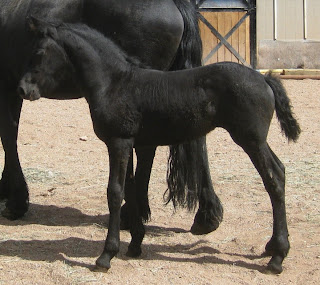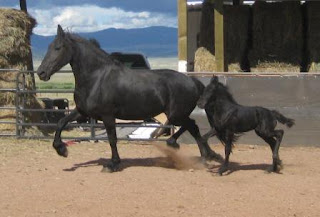I’m getting a lot of feedback on my posting about Premature foals and Joint ill. There are a lot of things out there that can cause loss of pregnancy, or premature birth. This blog post is going to go over things I’ve learned about late term loss and premature birth (besides the Joint ill already posted). I also want to pre appologize that this is a lot of text and not a lot of photos. It's a hard thing to picture a loved and wanted foal lost prematurely and it's just not something that should be displayed incase the wrong types of people read this post.
The first thing I want to address is the importance of vaccinating your mares with Pneumabort –KV. The KV stands for Killed Virus. That is the most important part in picking this vaccination. It is the vaccination for Equine Rhinopneumonities. It’s a virus that causes abortions in mares. There are other strands that affect the nervous systems and other systems but this particular virus has reproductive effects. The recommendation is to vaccinate the mare at 5, 7, 9 months of pregnancy. There are some breeders that suggest 3,5,7,9. Personally we do the 5,7,9 but if we lived in an area that was more susceptible I would probably just splurge and get the 3 month vaccination also. On Jefferspet.com the vaccinations are about 22$ so it’s not a big expense when you are talking about the possibility of saving your foal. In Australian the cost for the same shot is closer to $80 so it's not as affordable but if you have a high stud fee and have any horses that might be carriers it's worth it to give than to deal with a late term foal loss.
The other thing that was called to attention is Placentitis. This accounts for nearly 1/3 of the late term abortions, and can cause death the first day of life. The general definition is the inflammation of the placenta. As you should know if you are breeding the Placenta is essential to the connection between the mare and the foal. After 150 days it is almost 100% responsible for maintaining that foal.
At the cervix there is spot where the cervix connects to the placenta, commonly called the cervical star, or the spot where the foal breaks through when being born. You should also know that in a normal pregnancy the cervix is the barrier between the uterus and the outside world. So it won’t let bacteria or fungus in to affect the placenta. However one cause of placentitis is when the cervix allows bacteria through to the uterus thus affecting the baby. Causes of this can be poor confirmation, injury to the cervix from previous pregnancies, or bacteria degrading the cervical barrier.
Bacterial or fungal infection will lead to inflammation, causing increased prostaglandin (contraction hormone) leading to premature labor/birth. If birth does not occur the infection can cause defective growth from decreased placental functions causing premature death or death just after birth.
You may have heard the term “red-bag” as an abnormal situation for birthing. Well that is caused by the placenta not being attached properly at the time of birth. You have to break that sack ASAP so that the foal does not suffocate. You should also be very concerned about the health of the foal because it’s a clear sign that the placenta was not functioning properly and the foal will have had less oxygen, nutrients ect. while in there.
Toxins can also cross the blood barrier between the mare and foal if there is any colic or diarrhea. Infections that cause uterine infections can cause placentits, so a left over infection from pre breeding can cause it.
One sign of placentitis is that the mare's utters will bag up prematurely (we get concerned if it's before 300 days gestation, unless the mare is known for early births, aprox 30 days prior to birth is normal) The best and currently only real way to know if your mare is affected, is a rectal ultrasound to check the thickness of the placenta, separation, or changes in the cervical star. Please also have your vet check the fetal heartbeat. Sometimes the placenta will look absolutely normal but when samples are sent to a lab it’s clearly contaminated.
There are treatments if you can identify them early. Treat the infection and the inflammation and the progesterone level till birth. Consult a veterinarian for details about treating your specific situation. There are very few medications that can cross the placental connection so please make sure you discuss your situation with a reproductive specialist. We were advised to give one type of Sulfer based antibiotic that was in no way able to fix the problem and it resulted in a dead foal. We had used other forms in previous years and following years that did work. For the "incorrect form" we did ask the prescribing vet who falsely advised that it would work. Reconfirming post fetus death with specialist in the US we found that it was not an appropriate treatment for placentitis. We cannot tell you what medications you should or should not use on your horses because we are not practicing veterinarians but please know that not all sulfer based antibiotics are created equal. We will continue to use TMZ tabs for our mares.
EHV (Equine Herpes Virus) can cause fetal death. Type 1 and 4 are the common strands (which is why I discussed vaccinations right at the beginning) It is also a respiratory virus but the reproductive signs, abortion, will usually be the only symptom.
I looked up some odd and rare reasons and in the USA and AU it’s been known that Caterpillars can cause sudden abortion. They are ingested while grazing. Processional Caterpillar and Eastern Tent Caterpillar are the two types that I found listed.
We always hope that at the end of the 11 months we have a beautiful healthy baby but if things should not be so successful please share with us the information that you get so that we can help others
(photos 1 Grace 2012 pregnant with Maiko 373 colt Nemo www.sableranch.net/nemo.html , Photo 2 & 3 Ester and Mambo 2012 Maiko 373 Colt www.sableranch.net/mambo.html)
.jpg)






















.jpg)












